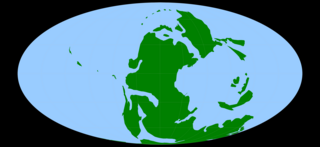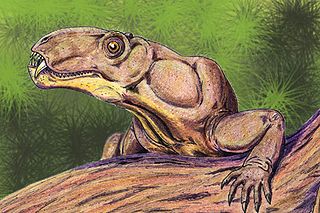
The Permian is a geologic period and stratigraphic system which spans 47 million years from the end of the Carboniferous Period 298.9 million years ago (Mya), to the beginning of the Triassic Period 251.902 Mya. It is the last period of the Paleozoic Era; the following Triassic Period belongs to the Mesozoic Era. The concept of the Permian was introduced in 1841 by geologist Sir Roderick Murchison, who named it after the region of Perm in Russia.

The Gzhelian is an age in the ICS geologic timescale or a stage in the stratigraphic column. It is the youngest stage of the Pennsylvanian, the youngest subsystem of the Carboniferous. The Gzhelian lasted from 303.7 to 298.9 Ma. It follows the Kasimovian age/stage and is followed by the Asselian age/stage, the oldest subdivision of the Permian system.

Embolomeri is an order of tetrapods or stem-tetrapods, possibly members of Reptiliomorpha. Embolomeres first evolved in the Early Carboniferous (Mississippian) Period and were the largest and most successful predatory tetrapods of the Late Carboniferous (Pennsylvanian) Period. They were specialized semiaquatic predators with long bodies for eel-like undulatory swimming. Embolomeres are characterized by their vertebral centra, which are formed by two cylindrical segments, the pleurocentrum at the rear and intercentrum at the front. These segments are equal in size. Most other tetrapods have pleurocentra and intercentra which are drastically different in size and shape.

The Nemegt Basin is a geographical area in the northwestern Gobi Desert, in Ömnögovi Province, southern Mongolia. It is known locally as the "Valley of the Dragons", since it is a source of many fossil finds, including dinosaurs, dinosaur eggs, and trace fossils.

Archeria is a genus of embolomere which lived in the Early Permian of Texas and Oklahoma. It was a medium-sized aquatic predator, with an elongated body and tail. The limbs were proportionally small but well-developed, connected to robust limb girdles. The skull was moderately long and low, up to 30 cm in length. Unlike most embolomeres, Archeria had many small chisel-shaped teeth instead of large fangs.

Otsheria is an extinct genus of anomodont, in the infraorder venyukovioidea. It lived in modern-day Russia during the Permian.

Intasuchus is an extinct genus of temnospondyl amphibian from the Middle Permian of Russia. It is known from a single species, Intasuchus silvicola, which was named in 1956. Intasuchus belongs to the family Intasuchidae and is probably its sole member, although other taxa such as Syndyodosuchus and Cheliderpeton have been assigned to the family in the past. Intasuchus most likely belongs to the group Archegosauroidea, Permian relatives of the large, mostly Mesozoic temnospondyl clade Stereospondyli.

Porosteognathus is an extinct genus of therocephalian therapsids. Remains have been found at Isheevo in Russia. It is known from the Middle Permian.

Archosaurus is an extinct genus of carnivorous proterosuchid archosauriform reptile. Its fossils are dated to the latest Permian of Russia and Poland, it is one of the earliest known archosauriforms. The type and only species is Archosaurus rossicus, known from several fragmentary specimens which cumulatively represent parts of the skull and cervical vertebrae. It would have been 3 metres (9.8 ft) long when fully grown.

Konzhukovia is an amphibian genus that belongs to an extinct family Konzhukoviidae of temnospondyls, the largest clade of basal tetrapods including about 198 genera, 292 species, and more than half of which were alive during the early Mesozoic period. The animal was a predator that lived about 260 million years ago, and could get up to about three meters in length. Specifically, Konzukovia lived during the Permian, between 252 and 270 million years ago according to the type of rock the fossil was found in. There are three species within this genus, K. vetusta, K. tarda, and K. sangabrielensis, the first two originating from Russia while the latest originating from Southern Brazil. The discovery of this specimen in Southern Brazil provided more evidence to support the idea that during this animals existence, there was a “biological corridor” because of the supercontinent Pangea, allowing these species to be found so far apart from each other. Konzhukovia belongs to the family Archegosauridae, a family consisted of large temnospondyls that most likely compare to modern day crocodiles. Since the discovery of the latest species, K. sangabrielensis, Pacheco proposes that there must be the creation of a new family, Konzhokoviidae, a monophyletic group in a sister-group relationship with Stereospondlyi in order to accommodate the three species. Konzhukovia skulls usually exhibit typical rhinesuchid features including an overall parabolic shape, small orbits located more posteriorly, and the pterygoids do not reach the vomer. These animals were long-snouted amphibians that had clear adaptations made for fish catching, as well as exemplifying aquatic features.

Dromotectum is an extinct genus of bystrowianid chroniosuchians from the Late Permian of China and Early Triassic of Russia. Two species have been named: the type species D. spinosum and the species D. largum. D. spinosum, the first species to be named, comes from Lower Triassic deposits in the Samara Region of European Russia and is known from the holotype PIN 2424/23, which consists of armor scutes, and from PIN 2424/65, 4495/14 and 2252/397. It was found in the Staritskaya Formation of the Rybinskin Horizon and named by I.V. Novikov and M.A. Shishkin in 2000. The generic name means “corridor with hipped vault” + “roof” (tecton), and the specific name means “spinous”. A second species, D. largum, was named by Liu Jun, Xu Li, Jia Song-Hai, Pu Han-Yong, and Liu Xiao-Ling in 2014 from the Shangshihezi Formation near Jiyuan in Henan province, China on the basis of specimen IVPP V 4013.1, a large scute.
Phaanthosaurus is an extinct genus of basal procolophonid parareptile from early Triassic deposits of Nizhnii Novgorod, Russian Federation. It is known from the holotype PIN 1025/1, a mandible. It was collected from Vetluga River, Spasskoe village and referred to the Vokhmian terrestrial horizon of the Vokhma Formation. It was first named by P. K. Chudinov and B. P. Vjushkov in 1956 and the type species is Phaanthosaurus ignatjevi.
Vonhuenia is an extinct genus of proterosuchid, a basal archosauriform from the Early Triassic of Russia. Fossils have been found in the Vokhminskaya Formation, along the Vetluga River that are Induan in age, making Vonhuenia one of the earliest archosauriforms.
Koinia is an extinct genus of temnospondyl amphibian from the Late Permian of Russia. It is an archegosauroid in the subfamily Melosaurinae. Koinia was named in 1993 with the description of the type species K. silantjevi, based on fossils that were found in the Ocher Assemblage Zone, near the Vym River in the Komi Republic.
Uralosuchus is an extinct genus of temnospondyl amphibian from the Late Permian of Russia, belonging to the group Archegosauroidea. It is a member of the archegosauroidean subfamily Melosaurinae. Fossils have been found in Orenburg Oblast. Uralosuchus was named in 1993 with the description of the type species U. tverdochlebovae.

Phthinosuchia is an extinct group of therapsids including two poorly known species, Phthinosuchus discors and Phthinosaurus borrisiaki, from the Middle Permian of Russia. Phthinthosuchus is known a partial crushed skull and Phthinosaurus is known from an isolated lower jaw. The two species have traditionally been grouped together based on their shared primitive characteristics, but more recent studies have proposed that they are more distantly related. Phthinosuchus is either a carnivorous gorgonopsian relative or an anteosaurian dinocephalian while Phthinosaurus is either a herbivorous rhopalodont dinocephalian or a therocephalian.
Taoheodon is an extinct genus of dicynodont therapsid from the Sunjiagou Formation in the Shanxi province of China, dated to the Wuchiapingian age of the Late Permian. Its type and only known species is T. baizhijuni. Taoheodon was a close relative of the well known Dicynodon, and may represent a biogeographical link between the South African Dicynodon and similar dicynodonts found in Laos.
The Sunjiagou Formation is a geological formation in Shanxi, China. It is of Lopingian age. The lower and middle parts of the formation consists of intensely bioturbated fine grained sandstones and thinly interbedded mudstones, deposited in a shallow-shore lake depositional environment, while the upper part consists of fine grained sandstone, siltstone and mudstone. Alongside the Naobaogou Formation, it has provided an important vertebrate fauna.

Seroherpeton is an extinct genus of embolomere known from the Late Permian aged Sunjiagou Formation of Northern China. It is the youngest known embolomere, with the previous youngest members being from the Cisuralian, and also lived further north than any other embolomere, with all other known members of the group being from Euramerica. It is known from a partial skull, consisting of portions of the maxilla, ectopterygoid, pterygoid and quadrate.
Eobaphetes is an extinct genus of embolomere which likely lived in the Pennsylvanian of Kansas. The genus is based on several skull and jaw fragments of a single individual. They were originally described under the species Erpetosuchus kansasensis, but this was later changed to Eobaphetes kansasensis when it was determined that Erpetosuchus was preoccupied by a Triassic reptile.


















